|
Michael McFadyen's Scuba Diving - Diving HMAS Hobart
HMAS Hobart was one of three "Charles F. Adams" class guided missile destroyers (DDG) built for the Royal Australian Navy. See the HMAS Hobart Page for more information on the ship.
HMAS Hobart was decommissioned on 12 May 2000 and given to the South Australian Government to be scuttled as a dive site. After a lot of work, the ship was scuttled on Melbourne Cup Day 5 November 2002 off Rapid Bay, about 85 kilometres by road south of Adelaide. The closest town where you can stay to dive the ship is Normanville, although there is other accommodation in a couple of small localities that do not have facilities like restaurants, pubs etc. See the Normanville Page for more information on facilities and dive services when diving the Hobart.
Access to the Hobart dive site is from the Wirrina Marina, which is about 10 kilometres south of Normanville. The new marina is completed although the infrastructure is still in the process of being constructed. The car parks are dirt, making changing into and out of dive gear a bit dirty and there are only temporary facilities like toilets, showers and office. However, there is a major building under construction and should be finished, I imagine, in mid-2003.
The scuttled wreck of the Hobart is located at GPS 35° 28' 09" S 138° 09' 05" E. The datum used was WGS84. If you use the wrong datum you may be about 220 metres off the wreck. See my GPS Page for more details and how to convert readings. The wreck is located about 9.4 kilometres to the west-north-west of the marina and is just over six kilometres from the nearest land. Even if you get within a kilometre you should be able to see the site as there are a dozen or more huge buoys over the wreck.
The ship lies roughly east-west, with the bow facing the shore. There are moorings all over the wreck, and the one you will use will depend on the dive boat and if others are there before you. The ship is 133.2 metres long and 14.2 metres wide. Displacing 4,570 tons, this was a large warship. Even with 50 divers at the site (easy considering that six charter boats and four private boats are permitted to moor at any one time) you will not encounter many divers during your explorations. On my first dive here there were at least 50 in the water and we only saw two other buddy pairs during our 45 minutes dive.
Where to start? Well, on your first dive it is probably best to do a quick tour over the outside and some of the main sections inside. On later dives you can concentrate on smaller sections of the ship. The bottom is just over 30 metres (at high tide) so you will not lose too much non-deco time dropping down for a look. If you are at the stern, drop to the sand and examine the prop shafts and rudders. The props were removed but the shafts can be seen for most of their length. There are also some huge flatheads on the sand here. If you are starting from amidships, drop over the side as you head towards the stern. From the bow, explore the deck till amidships and drop to the bottom. Also note the inlet/outlets along the side. These were for intake and discharge of sea water for condensing (cooling) steam from the turbine engines.
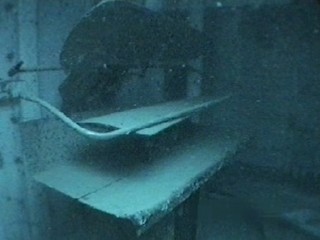 | 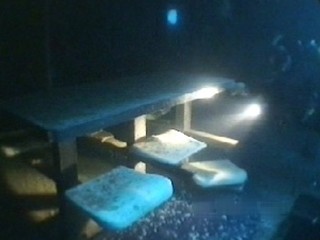 |
| The ironing press inside the laundry | The Cafeteria or Cafe of the Hobart |
If you start at the mid or rear section, enter the hull at the stern through the huge hole cut in the stern. Straight away you will see electrical equipment. You will soon note that the inside of this wreck is light, there is no way that you will ever get lost in here and no way that even without a light you will be in trouble. There are holes cut all over the place, in the deck, in the hull, in bulkheads, everywhere. Some are very large holes to permit multiple divers to enter, some are tiny to let water and light to flow through.
A good way to dive the wreck is to zig-zag along the length of the ship, staying on the one level till you need to go up a bit to stop going into decompression. Along the way you will see the first of many bathrooms, with stainless steel urinals, showers and porcelain toilet bowls. There are no huge bathrooms that I found but lots of smaller ones. You will also soon see the laundry, on the port side. There is a large washing machine, dryer and ironing press.
In the middle of the ship is the main mess, although a Royal Australian Navy Web Site says that it was called the Cafeteria and Jason Cooper (who served on the ship) said they called it the cafe. This also has the main galley adjacent. In the mess there are numerous eating tables with benches and where it meets the galley, there are food warming/cooling units. The galley has all the usual things, ovens, food preparation areas, sinks etc. Under the mess and galley is one of the engine rooms. There is an access way in the middle of the mess and an emergency exit nearby. More later.
Further forward you will find more bathrooms and some cabins. However, I never did figure out where the 333 crew would sleep, as there were very few noticeable signs of where this many men would sleep. Alex Wyschnja (who was one of the prime people responsible for the scuttling project) told me that most of the sailors slept at the rear of the ship near the missile magazine and that there were many bunks in the bow near the gun mount. There is a bathroom at the bow that would have been very uncomfortable in anything but slight seas and I do not think the cabins would have been much fun either. It appears that the bunks have been removed in the process of cleaning up the ship. The RAN Web Site says that the crew were housed in large rooms with 70 bunks.
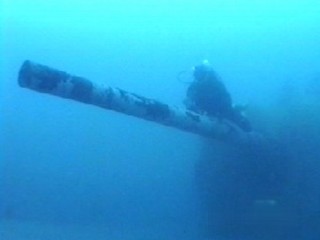 | 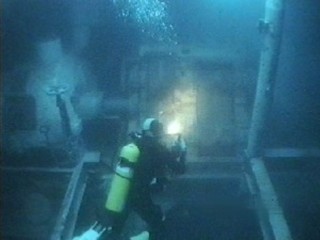 |
The forward gun of the Hobart
Andreas Thimm doing a Cher! | The gearbox for the starboard engine
Located in Engine Room 1 |
By the time you get to under the bridge area you will probably have to ascend a bit to the main deck. This enables you to explore the forward gun. This is pointing forward and has a plug blocking its barrel. The gun has a mirror periscope system which enable sighting. Under the gun there is a control board and chair where the operator would sit.
From here ascend to the bridge and examine it. There are two chairs but most, if not all, of the equipment has been removed. There is a plaque here commemorating the scuttling of the ship on the real wall. Behind the bridge is what appears to be the Captain's cabin. This has its own shower and toilet. There is also what appears to be the officers mess and galley behind this.
Under the bridge is the Operations Room. There are a lot of electronic equipment here, but most of the valuable (and reusable) items have been removed. Most of the dials and switches still work, we tried some and the voltmeter still recorded voltages in the batteries!
Ascending a bit more puts you near the funnels.
On a later dive, the only engine room accessible to divers can be explored in detail. This is actually the forward engine room. The rear engine room is not open to diving.
The ship had two Firerooms (boiler rooms) and two engine rooms. Boiler Room 1 is forward of Engine Room 1. Each boiler room had two boilers which were central to the room. The boiler fronts face each other so that the 70 stokers on the ship could attend to both boilers at the same time. As mentioned above, the boiler room is not accessible.
Behind this is Engine Room 1. This engine room is accessible and contains the starboard engine. Access is via many ways, through the hull on either side of the ship, through the mess or through the main deck between the funnels. This engine room contains a lot of machinery, although it is obvious that a lot has been removed. On the starboard side there is a large steam turbine and behind it, the gearbox. The gearbox's cover has fallen away and is on the floor. On the port side there is no engine! In fact, my thoughts when diving it was that it looked like there had never been a turbine there but as I had not read anything that said that the port engine was in a different compartment, I was not sure. Even diagrams of the ship I have managed to obtain do not show or mention anything. However, I was right, the port engine is aft of this engine room (in fact the port boilers are between them). There are two large generators above where normally a port engine would sit. Notice that the bottom of the engine room is covered in concrete, this was put there to make up for the lead ingots removed when preparing the ship for scuttling, presumably to ensure that it sank upright. All 206 tonnes of it! There may also have been a water distillation plant in this engine room.
Behind the starboard engine room is Boiler Room 2 which houses another two boilers set up exactly the same as the forward one. Again, this is not accessible to divers. Behind this is Engine Room 2 which contains the port engine. This runs through a short driveshaft to the prop. Once again, this is not open to divers.
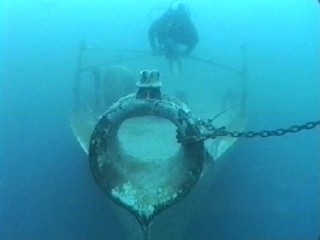 | 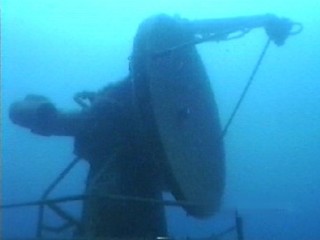 |
| The bow of the Hobart | The radar of the Hobart |
An interesting way to exit the engine room, although this should not be attempted by new, nervous or divers with twin tanks. At the bottom of the room, on the port side rear, there is a tunnel that rises up and comes out near the mess. It is a tight squeeze.
Another dive is to start at the bow. Swim to the bow along the deck and then examine the forward gun, winch, anchor mount and then drop over the bow and go to the sand. You will see the bulge of the sonar. You can enter the hull along the side and work your way back. You will eventually see many of the things that you have already noticed, but there will be other things that have not been noticed on your earlier dives. Some may include access holes to the Boiler Room (blocked). Basically you can exit wherever you want and ascend a bit.
Once you are back on the main deck, go to the stern area and examine this area. After this come back towards the rear funnel and you will see a radar dish, the rear gun and the missile launcher. You can swim inside the launcher.
After each dive, you can move from the funnel to the mooring that your boat is tied up to. Some moorings have ropes connecting them so you do not have to guess or descend to the deck.
You can easily average 45 minutes or more on a dive, so long as you keep ascending when your computer tells you that your bottom time is nearing zero. However, note that there are periods when the wreck has very strong currents, so when planning your trip, make sure that you pick the right time. Be sure to read my Normanville Page, especially the section relating to charter boats before making a decision when to visit.
CHARTER BOATS
There were originallye six approved charter boats that could take you to the Hobart. I used Divers Delight. However, I seem to recall that by 2013 there is hardly anyone servicing the wreck now. See my Normanville Page for more info, but it is probably out of date.
CODE OF PRACTICE
There is a "Code of Practice" that has been formulated to indicate to divers what is needed to dive this wreck. It is stated that "agreeing to comply with the code is a pre-condition to access" to the wreck (page 2 of Code). This code is the biggest load of rubbish related to scuba diving that I have ever read in my life.
Open Water Divers can only swim over the outside of the wreck and should not enter any section of the wreck that does not allow direct vertical access to the surface (that is 99% of the wreck) and limit their dive to 18 metres. Advanced Open Water Divers have the same restrictions but can go to 30 metres. Wreck Divers (Recreational) can enter the wreck but must stay within light areas. Technical Wreck Divers can enter all sections of the wreck and do decompression dives (none of the first mentioned divers can do deco dives). Cave/Penetration Divers can do the same as Technical Divers so I do not see why this is a specific category.
Even though I have completed over 3,400 dives, of which more than 860 dives have been deeper than 30 metres, with over 650 dives on shipwrecks, because I do not have a wreck certificate I am not supposed to enter the wreck where there is no direct vertical access to the surface. In addition, because I do not have technical wreck or cave diver training (I have only done more than 450 dives deeper than 40 metres, virtually all on shipwrecks), I am not supposed to enter the dark areas of the wreck. This is even more stupid as even if I did have such a certificate, I would need to carry with me:
- 2 tanks
- 3 lights
- 2 knives
- dive computer as well as depth and timing device
- decompression tables
- slate and pencil (why?)
- compass (!!!)
- 2 reels
- safety sausage
Get real! The only items on this list that are really needed are one tank, one torch and a computer. A safety sausage is a something I think everyone should also carry, but it is not essential for this dive. The rest are extra things to carry around, creating more drag and leading to the potential to get tangled on the wreck.
I should also state that the procedure for private boat owners to get permits to dive the wreck are so onerous as to be ridiculous. You cannot apply for a permit by mail, or email or over the internet. You have to personally travel into Adelaide to get a permit. Not just the owner of the boat, each person who is going to dive the wreck!
Anyway, it would appear that the operators are ignoring these aspects of the Code and not requiring divers to be equipped as indicated nor requiring them to have the training specified. This is a far easier dive than any dive in Chuuk Lagoon and far easier than all but a couple of the more basic dives on the SS President Coolidge.
SUMMARY
This is a very good dive, well worth travelling there from Sydney, Melbourne or Brisbane. Do it.
References:
| 
 v6.00.307 © 2003-2005
v6.00.307 © 2003-2005